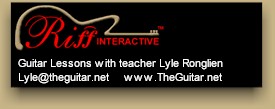Scroll through the lesson and click on notation/video/audio links to load the interactive players.
Please subscribe to get full access to all lessons for only $7.95/month PLUS 1 week free trial.

Riff Interactive lessons are
LESS expensive and
MORE interactive than alternatives!
More Info
|
|

Billy Gibbons (ZZ Top)
Style
Lesson 5
Lyle:
Tonight's lesson is in A minor and C minor. Let's begin with A minor. Here's the
jam track:
Lyle:
Billy Gibbons plays very tight rhythms and this is a great example of that.
Tight, muted up-strokes give this rhythm riff it's groove.
Lyle:
The riff here is using 3 chords, A, C and G. Most of Billy's riffs are played
with the minor pentatonic scale. Here's a couple patterns for you to learn:
Lyle:
Let's take a close look at a few riffs in the style of Billy Gibbons using this
scale. Riff 1 has a couple different types of bends, whole and quarter step
bends.
Lyle: I
like this next riff because it bends the root note up a whole step (10th fret,
2nd string).
Lyle:
Riff 3 is a simple riff, but the use of the different bend amounts is the
important part.
Lyle:
Riff 4 has a tough bend. You'll use your 1st finger to bend up a whole step (5th
fret, 3rd string).
Lyle:
Riff 5 uses hammer-ons and sliding:
Lyle:
Try playing these riffs along to the jam track. You can put them in any order
you want and also come up with your own variations.
GregV: Are you
pulling the g string down in riff 4?
Lyle: In the video clip you can see that I pull
it down towards the ground.
Lyle: Riff 6 uses the 1st finger again for a
whole step bend.
Lyle:
When playing the blues, you're mostly using the simple pentatonic scale. You
need to add lots of bends and vibrato to the riffs to add "feeling".
Lyle:
Just like in this next riff:
GregV: Are you
using your pick and fingers to get the squealing sound in
Riff6?
JimR: is
the squeal called a pinch harmonic?
Lyle: That's called "pinched
harmonics.
Lyle: The pick and side of your thumb hit the
string at about the same time. Try this technique with the bridge pickup on and
use distortion.
Lyle:
Riff 8 is what I call a "filler" riff. It's found in several styles and can be
used as a filler between other riffs.
Lyle:
Let's modulate to the key of C minor. Here's a few C minor pentatonic patterns
you can learn:
Lyle:
Here's a new jam track in C:
Lyle:
This is the same rhythm riff that you played earlier, but the position is a
little different.
Lyle:
Now let's look at a couple riffs in this new key. Riff 9 can be played with the
1st and 2nd fingers or the 2nd and 3rd.
Lyle:
Riff 10 is where you might want to use your 2nd and 3rd fingers because of the
slide down...
Lyle:
Riff 11 is a work-out for your bending technique. Bend a whole step with your
3rd finger, then half step with your index finger.
Lyle:
Here's another:
Lyle:
Riff 13 is yet another sliding type of riff:
Lyle:
Here's a jam track that switches back and forth between the two jams/keys we
worked on tonight - A minor and C minor, 16 bars/measures of each.
Lyle:
All of the riffs in this lesson can be used over the A and C rhythms, you'll
just have to transpose them to fit.
Lyle: Example: Riff 13 is in the C minor part of
this lesson, If you wanted to play it over the A rhythm riff, just move it down
3 frets.
Lyle: That's all for this
lesson.
Lyle: Thanks for being in our live lesson
tonight. Glad you enjoyed it. See you next time!
|
<< load notation from left
|
|
<< load audio from left
|
<< load audio from left
|